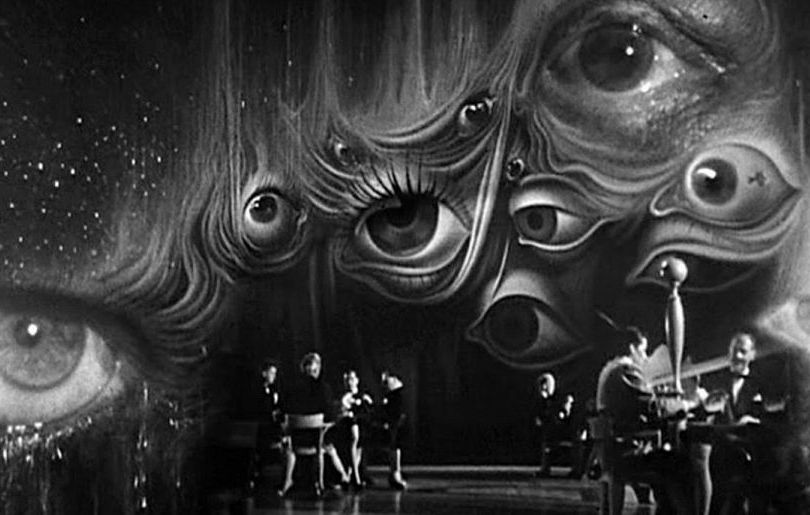Spellbound (lost sequence from Alfred Hitchcock film; 1945): Difference between revisions
No edit summary |
|||
| Line 1: | Line 1: | ||
{{ | {{InfoboxLost | ||
|title=Spellbound | |title=<center>Spellbound (lost sequence)</center> | ||
|image=Salvador Dali Spellbound.jpeg | |image=Salvador Dali Spellbound.jpeg | ||
|imagecaption=A shot of the dream sequence that remained in the film | |imagecaption=A shot of the dream sequence that remained in the film. | ||
|status= | |status=<span style="color:red;">'''Lost'''</span> | ||
}} | }} | ||
''Spellbound'' is a 1945 film directed by Alfred Hitchcock. The film focuses on psychoanalysis, and Hitchcock hired Spanish surrealist artist Salvador Dalí to design the key dream sequence in the film. '''The original sequence designed by Dalí was 20 minutes long, but most of it was cut by the producer, David O. Selznick'''. Only 2 minutes of Dalí's dream sequence appears in the final film, and the remainder has not been found. | |||
==Content of the | ==Content of the Scene== | ||
On October 25th, 1944, David O. Selznick wrote: "The more I look at the dream sequence for ''Spellbound'', the worse I feel it to be… It’s not Dalí’s fault, for his work is much finer and much better for the purpose than I ever thought it would be. It is the photography, set-ups, lighting, et cetera."<ref>[https://www.artsy.net/article/artsy-editorial-dali-hitchcock-brought-surrealism-hollywood | On October 25th, 1944, David O. Selznick wrote: <blockquote>"The more I look at the dream sequence for ''Spellbound'', the worse I feel it to be… It’s not Dalí’s fault, for his work is much finer and much better for the purpose than I ever thought it would be. It is the photography, set-ups, lighting, et cetera."<ref>[https://www.artsy.net/article/artsy-editorial-dali-hitchcock-brought-surrealism-hollywood When Salvador Dalí and Alfred Hitchcock Brought Surrealism to Hollywood - Artsy] Retrieved 24 Feb '21</ref></blockquote> | ||
Ingrid Bergman, an actress in the film, felt, however, that the original scene was much more effective, and said that "It was much longer and more interesting. It was really something to put in a museum. The final files did not include this complicated footage, in which I became a plaster statue in the man's dream (which meant we shot the film backward, with me breaking out of it). There were so many wonderful things in it, but they decided to cut it down to a minute or two instead of the twenty-minute sequence we worked so hard on. It was such a pity. It could have been really sensational."<ref>[https://archive.org/details/darksideofgenius00spot_0/page/276/mode/2up ''The | Ingrid Bergman, an actress in the film, felt, however, that the original scene was much more effective, and said that: <blockquote>"It was much longer and more interesting. It was really something to put in a museum. The final files did not include this complicated footage, in which I became a plaster statue in the man's dream (which meant we shot the film backward, with me breaking out of it). There were so many wonderful things in it, but they decided to cut it down to a minute or two instead of the twenty-minute sequence we worked so hard on. It was such a pity. It could have been really sensational."<ref>[https://archive.org/details/darksideofgenius00spot_0/page/276/mode/2up ''The Dark Side Of Genius: The Life Of Alfred Hitchcock'', page 276.] Retrieved 24 Feb '21</ref></blockquote> | ||
==References== | ==References== | ||
{{reflist}} | {{reflist}} | ||
[[Category:Lost films]] | |||
[[Category:Completely lost media]] | |||
[[Category:Historic]] | |||
Revision as of 20:19, 25 February 2021
Spellbound is a 1945 film directed by Alfred Hitchcock. The film focuses on psychoanalysis, and Hitchcock hired Spanish surrealist artist Salvador Dalí to design the key dream sequence in the film. The original sequence designed by Dalí was 20 minutes long, but most of it was cut by the producer, David O. Selznick. Only 2 minutes of Dalí's dream sequence appears in the final film, and the remainder has not been found.
Content of the Scene
On October 25th, 1944, David O. Selznick wrote:
"The more I look at the dream sequence for Spellbound, the worse I feel it to be… It’s not Dalí’s fault, for his work is much finer and much better for the purpose than I ever thought it would be. It is the photography, set-ups, lighting, et cetera."[1]
Ingrid Bergman, an actress in the film, felt, however, that the original scene was much more effective, and said that:
"It was much longer and more interesting. It was really something to put in a museum. The final files did not include this complicated footage, in which I became a plaster statue in the man's dream (which meant we shot the film backward, with me breaking out of it). There were so many wonderful things in it, but they decided to cut it down to a minute or two instead of the twenty-minute sequence we worked so hard on. It was such a pity. It could have been really sensational."[2]
References
- ↑ When Salvador Dalí and Alfred Hitchcock Brought Surrealism to Hollywood - Artsy Retrieved 24 Feb '21
- ↑ The Dark Side Of Genius: The Life Of Alfred Hitchcock, page 276. Retrieved 24 Feb '21
